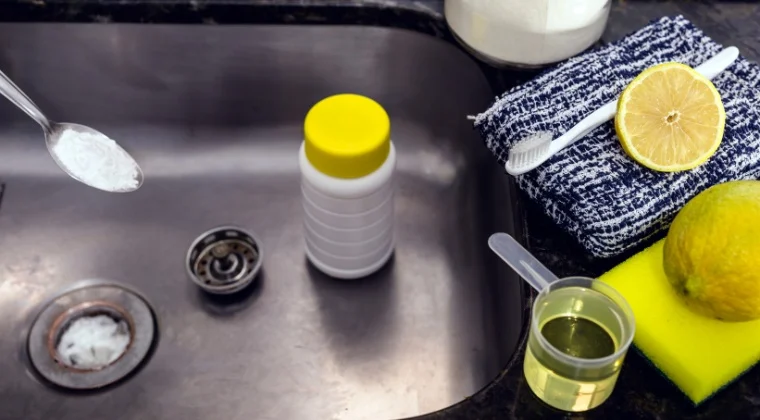
The Ultimate Guide to Vinegar and Baking Soda for Clogged Drains
Exploring natural remedies for clogged drains, such as vinegar and baking soda, has gained popularity in household maintenance routines.
The simple combination of these two ingredients is often praised for its efficacy, but does it truly hold up to the task?
Let's uncover the intricacies of this method and evaluate whether it's a reliable solution for your drainage woes.
Key Takeaways
- Baking soda and vinegar are effective for minor drain clogs.
- The chemical reaction helps break down blockages.
- Use caution with older pipes to avoid damage.
- Seek professional help for stubborn or severe clogs.
How does Vinegar and Baking Soda Work on Clogged Drains?
Vinegar and baking soda work on clogged drains through a chemical reaction that creates fizzing and foaming.
This reaction helps break down minor clogs by loosening debris, making it easier to flush away with hot water.
Understanding the mechanism of this reaction is important in effectively utilizing these household items for drain maintenance.
Chemical Reaction Between Vinegar and Baking Soda
The chemical reaction between baking soda and vinegar creates a fizzing effect that aids in dislodging minor clogs in drains by generating carbon dioxide gas.
This reaction between vinegar and baking soda helps break down debris and buildup, assisting in clearing minor blockages.
The carbon dioxide bubbles produced during the reaction can also help push obstructions along the drain.
Mechanism of Unclogging Drains with Baking Soda and Vinegar
Utilizing a natural chemical reaction, baking soda and vinegar work synergistically to effectively break down minor clogs in drains and assist in maintaining ideal drainage functionality.
Below is a table illustrating the mechanism of unclogging drains with baking soda and vinegar:
| Action | Effect |
|---|---|
| Baking soda and vinegar reaction | Breaks down minor clogs effectively |
| Baking soda abrasiveness | Scrubs away debris in the pipes |
| Vinegar acidity | Dissolves mineral deposits and grime in the drain |
Benefits of Using Vinegar and Baking Soda to Unclog Drains
Using vinegar and baking soda to unclog drains presents several benefits that make it an appealing choice for many households.
The natural cleaning alternatives offer a safe and eco-friendly solution to common drain issues.
Additionally, the cost-effective nature of this method provides an economical way to maintain clean and odor-free drains.
- Natural Cleaning Alternatives
- Cost-Effective Drain Cleaning Solution
- Environmentally Friendly Drain Unclogging Method
Natural Cleaning Alternatives
For effective and environmentally friendly drain cleaning, incorporating vinegar and baking soda offers a natural solution that is both gentle on pipes and cost-effective.
When dealing with a drain clog, this DIY method using baking soda and vinegar can effectively break down grease and minor blockages.
The natural cleaning properties of these ingredients make them a safer alternative to harsh chemical cleaners.
Do you have problem with your drain pipe? Learn more about unclogging a drain pipe
Cost-Effective Drain Cleaning Solution
A cost-effective and environmentally friendly approach to maintaining clear and odor-free drains involves harnessing the natural cleaning properties of vinegar and baking soda.
When looking to unclog a drain naturally, using a mixture of baking soda and vinegar can be an effective cleaner.
This method, preferred by those who aim for regular cleaning, is gentle on pipes and septic systems, reducing the need for a plumber's intervention.
The fizzing reaction initiated by combining these two ingredients can help break down minor clogs, making it a suitable option for routine maintenance.
Environmentally Friendly Drain Unclogging Method
To maintain clear and odor-free drains while embracing a cost-effective and environmentally friendly approach, harnessing the natural cleaning properties of vinegar and baking soda proves to be a practical solution.
Step-by-Step Guide to Using Vinegar and Baking Soda for Clogged Drains
To effectively utilize vinegar and baking soda for unclogging drains, follow these steps:
- Prepare a mixture of equal parts of baking soda and vinegar.
- Apply this mixture directly into the clogged drain.
- Allow it to sit for a recommended duration.
- Finally, flush the drain thoroughly with boiling water to clear any loosened debris and guarantee best results.
Preparation and Mixing of Baking Soda and Vinegar
In the process of combating clogged drains effectively, the initial step involves mixing 1/2 cup of baking soda with an equal amount of vinegar in a measuring cup to create a fizzing solution.
The reaction produced by the baking soda and vinegar mixture helps break down the clog in the drain.
Remember to cover the drain opening to contain the reaction and let it sit for 5 to 10 minutes.
| Ingredients | Measurement |
|---|---|
| Baking Soda | 1/2 cup |
| Vinegar | 1/2 cup |
| Water (for flushing) | As needed |
After allowing the mixture to work on the clog, flush the drain with boiling water to effectively clear out the loosened debris.
Application of the Mixture in the Clogged Drain
For best results in clearing clogged drains using vinegar and baking soda, it is advisable to first pour boiling water down the drain to alleviate minor blockages and prepare the drain for the subsequent solution.
To apply the mixture, combine 1/2 cup of baking soda with 1 cup of vinegar and pour it down the drain.
This will initiate a foaming reaction that aids in breaking up the clog within the drain trap.
Cover the drain to contain the fizzing action and let the solution sit for 5 to 10 minutes, allowing it to penetrate and loosen the blockage effectively.
Flushing the Drain with Boiling Water
Flush the drain with boiling water to effectively prepare it for the subsequent vinegar and baking soda mixture, ensuring peak unclogging results.
Boiling water is essential in breaking down initial debris and greasy build-up within the drain.
The heat from the boiling water helps to soften the clog, making it easier for the baking soda and vinegar solution to effectively unclog the drain.
This step is vital to prepare the drain, allowing the baking soda and vinegar mixture to work at its full potential.
By flushing with boiling water after the treatment, any loosened clog material is thoroughly cleared from the drain, ensuring a successful unclogging process.
Tips for Maintaining Clean Drains Using Baking Soda and Vinegar
When it comes to maintaining clean drains using baking soda and vinegar, there are key tips to take into account.
By following these simple steps, you can guarantee the longevity and efficiency of your plumbing system.
- Establish a regular drain cleaning routine.
- Implement preventive measures to avoid clogs.
- Use natural methods to keep drains flowing smoothly.
Regular Drain Cleaning Routine
Regular maintenance of drains incorporating baking soda and vinegar is a practical and eco-friendly approach to prevent clogs and maintain peak drainage functionality.
Below is a table highlighting key points for maintaining clean drains using baking soda and vinegar:
| Key Point | Description | Benefit |
|---|---|---|
| Weekly Cleaning | Using baking soda and vinegar weekly can eliminate odors and keep drains fresh | Prevents clogs and odors |
| Sink Strainers | Installing sink strainers helps prevent debris from clogging drains | Reduces blockages |
| Proper Disposal Practices | Disposing of grease and food waste correctly complements cleaning efforts | Maintains cleanliness |
Preventive Measures to Avoid Clogs
To effectively prevent clogs and maintain clean drains, incorporating a regular cleaning routine with baking soda and vinegar may help.
Here are some preventive measures to avoid blockages in sink drains:
- Use Sink Strainers: Install strainers to catch debris like food particles and hair, preventing them from entering and clogging the drains.
- Avoid Pouring Grease and Oil: Dispose of grease and oil in the trash instead of pouring them down the drain, reducing the likelihood of grease blockages.
- Regular Cleaning: Clean sinks regularly to prevent debris buildup and blockages, especially after activities like handling raw meat, to maintain clean and clog-free drains.
Common Questions About Vinegar and Baking Soda for Clogged Drains
Can Baking Soda and Vinegar Be Used in All Types of Drains?
Baking soda and vinegar constitute a versatile and commonly utilized solution for addressing drain clogs across a variety of fixtures.
Below is a comparison table showcasing the compatibility of baking soda and vinegar with different drain types:
| Drain Type | Compatibility with Baking Soda and Vinegar |
|---|---|
| Kitchen Sinks | Effective for minor clogs and food residue |
| Bathroom Sinks | Suitable for hair and soap residue clogs |
| Tubs | Can help with organic material blockages |
| Other Fixtures | May not be as effective for tough clogs |
Considering these factors, baking soda and vinegar are generally safe and beneficial for common household drains, particularly for addressing minor clogs and food residue.
Is It Safe to Use Baking Soda and Vinegar in a Garbage Disposal?
Considering the versatility of baking soda and vinegar in addressing drain clogs across various fixtures, it is important to note the safety and effectiveness of their use in a garbage disposal for cleaning and deodorizing purposes.
When used in a garbage disposal, the fizzing reaction between baking soda and vinegar helps break down grease and food particles, aiding in clearing the disposal.
What Should You Do If the Clog Persists After Using Vinegar and Baking Soda?
If the clog persists despite the use of vinegar and baking soda, it is advisable to contemplate utilizing a plunger or a drain snake to further dislodge the blockage.
Clogged drains? Our Professional Plumbers Can help
When faced with persistently clogged drains, seeking assistance from our professional plumbers is the most effective solution to guarantee thorough and lasting remediation.
Berkeley Plumbing Pros possess the expertise needed to tackle even the toughest clogs, ensuring your drains run smoothly and efficiently.
Don't let clogged drains disrupt your daily routine. Contact our professional plumbers for a quick and reliable solution.

